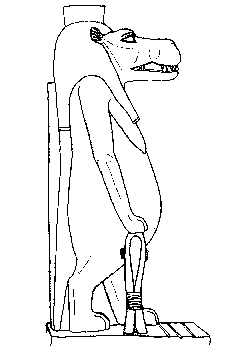
Tauret, también conocida por el nombre griego de Tueris, es una de las diosas hipopótamo, las otras son Opet y Reret. Iconográficamente, esas diosas no pueden diferenciarse unas de otras. Son criaturas híbridas, con el cuerpo de un hipopótamo hembra preñado, la espalda de un cocodrilo, las patas de un león y las manos de un hombre.
Las funciones más importantes de las diosas hipopótamo son las de madre y nodriza. Sus atributos más importantes son el lazo-sa y el signo-anj; sus funciones son principalmente apotropaicas en bodas y nacimientos. También ayudan al nacimiento del sol, que en ocasiones era visto como una madre diosa dando a luz. Representaciones de diosas hipopótamo aparecen en cuchillos mágicos, en escaños, cabezales y camas; de hecho, se han encontrado amuletos con representaciones de una diosa hipopótamo en casas de El-`Amarna. En el Imperio Nuevo aparece como la constelación de los cielos septentrionales, a menudo con un cocodrilo sobre su espalda. A partir de la Dinastía XXVI adquirió también la función de una diosa del mes.
El nombre Tauret, que significa 'la gruesa', puede que date de comienzos del Imperio Nuevo y probablemente provenga de su asociación con diosas madres como Hathor e Isis. La relación con Hathor es algo habitual; Tauret lleva a menudo los cuernos de vaca y el disco solar característicos de Hathor. Era particularmente reverenciada en el área en torno a Tebas; en Deir el-Medina se han encontrado muchas jarras de libación y estelas que muestran a Tauret junto a Hathor. Representaba un papel especial en Gabal el-Silsila (Eg. Jeny), a 145 km al sur de Luxor, donde el río es muy estrecho. Como 'imit-nnw', estaba relacionada con la inundación anual y aparece representada en varias capillas con la cara de una mujer y el tocado de Hathor.
Incidentalmente, mencionaremos que los hipopótamos machos eran considerados destructivos y estaban asociados a Seth.